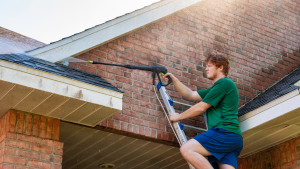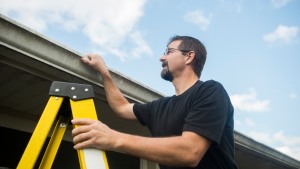If you’re a homeowner, you may have noticed cracks in your stucco walls. When should you have them fixed? At what point does improving something become obligatory?
The stucco on several buildings has developed cracks. A common problem with stucco walls is that they often develop cracks. If your home is covered with stucco, you should learn about the causes of cracking and the recommended frequency of stucco repairs.
Here’s a guide to what’s causing them, how to fix them, and when to fix stucco cracks.
Many different kinds of cracks may appear in stucco walls. Stucco cracks may occur for a variety of reasons, and understanding those causes is key to making effective repairs.
Here’s what you should look for to figure out what cracks you have in your stucco.
Hairline Cracks: The width of these splits is typically 1/16 of an inch or less. The majority of the cracks you encounter will look like this. There are several possible triggers for them to occur. Most often seen in newly constructed houses due to plaster shifting and settling. Wood dries out, foundations shift, and construction all contribute to the occasional appearance of tiny cracks.
Foam Trim Cracks: Even the foam moldings used with stucco may develop fissures with time. Seeing cracking here indicates that fiberglass mesh tape was not utilized during the foam trim installation. Eventually, cracking will occur as a result of expansion and contraction.
Spider Cracking: These holes in your stucco have earned that unflattering moniker because they resemble spider webs. If your stucco looks like this, the base coat needed more time to dry. This may have happened if there was excessive water in the mixture, if it dried too rapidly, or if the weather could have been better on the day it was applied.
Pattern Cracking: Walls may develop cracks in a predictable sequence. Typically, it will appear as a pattern of horizontal and vertical lines on your stucco. Problems with the lath’s installation lead to this cracking. Most likely, it wasn’t fastened on securely, therefore additional cracks will appear in due time.
Diagonal Cracking: As the name says, these fissures are perpendicular to the surface they surround and often appear in the vicinity of windows and doors. Caused by ground movement associated with earthquakes, they occur whenever the structure’s foundation undergoes significant alterations. You should prioritize fixing these cracks if they are larger than those in your stucco.
When to Repair Stucco Cracks
So, when is the right time to fix those stucco cracks you’ve noticed?
As soon as possible is the short response.
As soon as you see a crack, no matter how minor, you should take care of it. Despite its seeming insignificance at the moment, it might grow and become a bigger problem later on. You can halt that crack in its tracks if you fill it in.
Your attention to detail would be much appreciated. To safeguard your dwelling. Water seeping into stucco’s crevices may lead to mold and mildew. Repairing one of these might be challenging if you wait too long, so fixing that crack as soon as you see it is preferable.
How to Repair Cracks
To fix cracks in your stucco, you must first determine how the crack originated.
- A hairline crack may be securely filled up to stop its further progress.
- More work will be involved, or you may need to bring in experts if the crack is diagonal or has a pattern.
A tiny chip or crack that only extends a tiny bit can be easily repaired. You can find a wide variety of valuable items to use for that purpose at your neighborhood hardware store. If you’re having trouble deciding, the store’s employees will be happy to offer advice.
DIY
Acrylic caulk is the most widely available product for this purpose.
- You should use a wire brush to remove debris once the fracture has been widened to approximately a quarter of an inch in width.
- Then, seal the gap using the mixture and a standard caulking gun.
- After 24 hours, you can paint over the caulk with water-based paint.
When to Call the Pros
If the stucco has developed pattern cracks, the lath beneath it must be fixed or replaced. To get to it, the stucco will have to be taken down. After the lath has been properly fastened, new stucco can be applied.
Wide or angular Cracks are a warning sign of a problem with your home’s foundation. Otherwise, the foundation will continue to deteriorate, and you’ll have to call in the pros to fix it. Professional inspectors the foundation of your home to find the best method of fixing it.
How to Stop Stucco from Cracking in the Future
Now that you’ve patched up the damage to your stucco, you want to make sure it doesn’t break again.
How can you be sure that stucco repairs won’t be necessary for the future?
The finish depends on the quality of the stucco, so if you want the greatest results, you’ll need to apply fresh stucco.
- Avoid water damage and cracks by using an excellent water-resistant barrier in the stucco.
- The lath must be properly laid to prevent cracks.
Other installation techniques minimize the appearance of fissures. Inquire about control joints, casing beads, and corner beads with the building crew. They help relieve pressure on the stucco, making cracking less likely.
Conclusion
You may avoid significant issues with your stucco if you take precautions and inspect it often. If you fix little problems as soon as you see them, you may prevent them from becoming more significant. If you see any cracks in your stucco, it’s preferable to fix them right away.
If they turn out to be bigger or more difficult than you anticipated, it’s time to bring in the big guns.
By maintaining it in this manner, your stucco will last many years.




